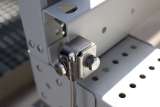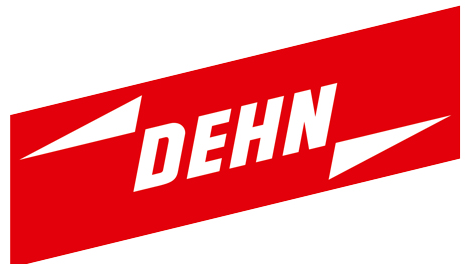DEHN – Hard as steel: the new connection clamp from DEHN
Integrating steel girders, metal sheets, or profiles into lightning protection or equipotential bonding systems often presents a challenge.
This is particularly true when protective coatings against corrosion prevent the direct, conductive connection that is essential for effective lightning current discharge or equipotential bonding. The new connection clamp for steel girders from DEHN overcomes this hurdle with a special blade that penetrates coated surfaces up to 0.2 mm without damaging the surface protection. It is therefore particularly suitable for buildings with metallic structures, such as industrial plants, halls, and multi-storey car parks.
The clamp is made of high-quality materials and can be used wherever an electrical connection to steel girders, sheets, and profiles is required. With a variable clamping range of 3 to 52 mm, it offers maximum flexibility during installation. The product is approved for use in Zone 2/22 hazardous areas and has a high lightning current carrying capability of up to 100 kA (10/350 μs). It fulfils the requirements of the DIN EN 62561-1 standard and provides a permanently safe, electrically conductive connection even under high loads during a lightning strike.
The clamp is available in various designs and materials, both in stainless steel (V2A) and galvanised steel (HDG), with a double clamp or connection bracket. Suitable for round and flat material as well as cables, it is extremely versatile. Typical applications include lightning equipotential bonding with round wire, the installation of air-termination rods without drilling, or the connection of steel girders to earthing systems using connection lugs. The special 7-segment digits also allow use as a test joint, an additional advantage when it comes to testing or maintenance.

For the reliable integration of steel girders, metal sheets, or profiles into lightning protection or equipotential bonding systems: the new connection clamp for steel girders from DEHN
SourceDEHN
EMR Analysis
More information on DEHN: See the full profile on EMR Executive Services
More information on Dr. Philipp Dehn (Chairman of the Board & Chief Executive Officer, DEHN SE + Chairman, ZVEI): See the full profile on EMR Executive Services
More information on The German Institute for Standardization – Deutsche Institut für Normung (DIN): https://www.din.de/en + The German Institute for Standardization (DIN), offers all interested parties a platform for the development of norms and standards as a service to business, government, and society.
DIN is a privately owned company with the legal status of a non-profit association. Its headquarters have been in Berlin since 1917.
DIN’s primary task is to develop consensus-based standards, in close cooperation with stakeholders, in line with market needs and in a timely manner. Around 28,000 experts contribute their expertise to standardization work. Based on an agreement with the Federal Republic of Germany, DIN is recognized as the national standardization organization within European and international standardization organizations.
Today, almost 90 percent of DIN’s standardization work has a European and international focus.
More information on Christoph Winterhalter (Chairman of the Executive Board, DIN): https://www.din.de/en/din-and-our-partners/din-e-v/organization/executive-board + https://www.linkedin.com/in/christoph-winterhalter/
More information on DIN EN 62561-1 by The German Institute for Standardization – Deutsche Institut für Normung (DIN): https://www.dinmedia.de/en/standard/din-en-62561-1/278349429 + DIN EN 62561-1, published by the German Institute for Standardization (DIN), specifies requirements for connection components in lightning protection systems. It is the German version of the European standard EN 62561-1, which in turn is based on the International Electrotechnical Commission (IEC) standard IEC 62561-1. This standard focuses on metallic connection components like connectors, bonding and bridging components, expansion pieces, and test joints, ensuring they meet the necessary criteria for safe and effective lightning protection.
EMR Additional Notes:
- Grounding and Bonding, Surge, Transient, Earth and Lightning Protection / Arresters Devices:
- Grounding and Bonding:
- Grounding is connecting an electrical system or equipment to the earth, creating a safe path for electricity to dissipate into the ground.
- Bonding is the electrical connection of multiple exposed metal surfaces to each other and to the grounded system, ensuring they are all at the same electrical potential to prevent shock hazards.
- Together, grounding and bonding create a stable, unified, and safe electrical environment by providing a clear fault path and preventing dangerous voltage differences.
- Equipotential Bonding is a specific type of bonding that connects separate metallic parts (like pipes, metal enclosures, or structural steel) so they are at the same electrical potential. The purpose of equipotential bonding is to prevent potential differences and the risk of electric shock or fire that could occur if a person touched two different conductive objects at significantly different voltages, especially during a fault.
- Surge:
- Sudden increase in voltage that lasts for three nanoseconds or more is called a voltage surge.
- Surge protectors are also known as Transient Voltage Surge Suppressor (TVSS), Surge Protection Devices (SPD) or Surge Suppression Equipment (SSE). These are pieces of equipments designed to protect electrical and electronic equipment from power surges and voltage spikes.
- A surge protector limits the voltage supplied to the electrical devices to a certain threshold, by short-circuiting current to ground or absorbing the spike when a transient occurs, thus avoiding damage to the devices connected to it.
- A surge protector does not interrupt the flow of power. It simply diverts it until the voltage returns to normal. While surge arresters also do this, they often come equipped with a crowbar circuit that acts as a failsafe. If there is a malfunction, the crowbar will interrupt the current.
- Sudden increase in voltage that lasts for three nanoseconds or more is called a voltage surge.
- Transient:
- A temporary unwanted voltage in an electrical circuit that range from a few volts to several thousand volts and lasts from micro seconds up to a few milliseconds.
- => Surge vs. Transient:
- Surges are generally of longer duration but have lower peak voltage and/or current amplitude, while transients are of shorter duration and, usually, higher peak amplitude.
- Earthing and Lighting:
- Earthing ensures that any electrical faults are safely directed to the ground, minimizing the risk of damage or injury usually done by driving ground rods or a horizontal grid of near surface bare conductors under the ground.
- Lightning protection is a system of devices and components designed to protect a building and its occupants from the damaging effects of lightning strikes.
- Grounding and Bonding:
- ATEX and IEC Ex:
- ATEX zones are defined areas where an explosive atmosphere, created by flammable gases, vapors, mists, or dusts, can pose a risk of explosion. Equipment used in these environments must be certified to meet ATEX safety requirements.
- The term ATEX is from the French Atmosphères Explosibles, referring to a European directive that sets safety requirements for such environments. Zones are classified (0, 1, 2 for gases/vapors and 20, 21, 22 for dusts) based on the likelihood of an explosive atmosphere being present, with lower numbers indicating a higher risk.
- Gas/Vapor Zones (Zones 0, 1, 2)
- Zone 0: A high-risk area where an explosive atmosphere is present continuously, or for long periods or frequently.
- Zone 1: A moderate-risk area where an explosive atmosphere is likely to occur occasionally during normal operation.
- Zone 2: A low-risk area where an explosive atmosphere is unlikely to occur in normal operation, and if it does, it will only be for a short period.
- Dust Zones (Zones 20, 21, 22)
- Zone 20: A high-risk area where combustible dust is present continuously, over long periods, or frequently.
- Zone 21: A moderate-risk area where combustible dust may form occasionally during normal operation.
- Zone 22: A low-risk area where combustible dust does not usually occur in normal operation, or only rarely and for a short time.
- Gas/Vapor Zones (Zones 0, 1, 2)
- The ATEX Directive from the European Union (https://eur-lex.europa.eu/eli/dir/2014/34/oj/eng) covers equipment and protective systems intended for use in potentially explosive atmospheres.
- While ATEX and IEC Ex certifications are very similar in their technical requirements, the main difference is geographical acceptance:
- ATEX is a mandatory requirement in Europe.
- IEC Ex is an international scheme that is accepted across several countries globally.
- Fundamental Units of Electricity:
- Ampere – Amp (A):
- Amperes measure the flow of electrical current (charge) through a circuit. Ampere (A) is the unit of measure for the rate of electron flow, or current, in an electrical conductor.
- One ampere is defined as one coulomb of electric charge moving past a point in one second. The ampere is named after the French physicist André-Marie Ampère, who made significant contributions to the study of electromagnetism.
- Milliampere (mA) is a unit of electric current equal to one-thousandth of an ampere (1mA=10−3A). The prefix “milli” signifies 10−3 in the metric system. This unit is commonly used to measure small currents in electronic circuits and consumer devices.
- Volts measure the force or potential difference that drives the flow of electrons through a circuit.
- Kilovolt (kV) is a unit of potential difference equal to 1,000 volts.
- Watts measure the rate of energy consumption or generation, also known as power.
- Amperes measure the flow of electrical current (charge) through a circuit. Ampere (A) is the unit of measure for the rate of electron flow, or current, in an electrical conductor.
- Power vs. Energy: how electricity is measured and billed.
- Power (measured in kW, MW, GW, TW): Rate at which energy is used or generated at a given moment.
- Energy (measured in kWh, MWh, GWh, TWh): Total amount of power consumed or generated over a period of time (i.e., Power x Time).
- Real Power Units: actual power that performs work.
- Kilowatt (KW):
- A kilowatt is simply a measure of how much power an electric appliance consumes—it’s 1,000 watts to be exact. You can quickly convert watts (W) to kilowatts (kW) by dividing your wattage by 1,000: 1,000W 1,000 = 1 kW.
- Megawatt (MW):
- One megawatt equals one million watts or 1,000 kilowatts, roughly enough electricity for the instantaneous demand of 750 homes at once.
- Gigawatt (GW):
- A gigawatt (GW) is a unit of power, and it is equal to one billion watts.
- According to the Department of Energy, generating one GW of power takes over three million solar panels or 310 utility-scale wind turbines
- Terawatt (TW):
- One terawatt is equal to one trillion watts (1,000,000,000,000 watts). The main use of terawatts is found in the electric power industry, particularly for measuring very large-scale power generation or consumption.
- According to the United States Energy Information Administration, America is one of the largest electricity consumers in the world, using about 4,146.2 terawatt-hours (TWh) of energy per year.
- Kilowatt (KW):
- Apparent Power Units: measures the total power in a circuit, including power that does not perform useful work.
- Kilovolt-Amperes (kVA):
- Kilovolt-Amperes (kVA) stands for Kilo-volt-amperes, a term used for the rating of an electrical circuit. A kVA is a unit of apparent power, which is the product of the circuit’s maximum voltage and current rating.
- The difference between real power (kW) and apparent power (kVA) is crucial. Real power (kW) is the actual power that performs work, while apparent power (kVA) is the total power delivered to a circuit, including the real power and the reactive power (kVAR) that doesn’t do useful work. The relationship between them is defined by the power factor. Since the power factor is typically less than 1, the kVA value will always be higher than the kW value.
- Megavolt-Amperes (MVA):
- Megavolt-Amperes (MVA) is a unit used to measure the apparent power in a circuit, primarily for very large electrical systems like power plants and substations. It’s a product of the voltage and current in a circuit.
- 1 MVA is equivalent to 1,000 kVA, or 1,000,000 volt-amperes.
- Kilovolt-Amperes (kVA):
- Specialized Power Units: used specifically for renewable energy, especially solar.
- KiloWatt ‘peak’ (KWp):
- kWp stands for kilowatt ‘peak’ power output of a system. It is most commonly applied to solar arrays. For example, a solar panel with a peak power of 3kWp which is working at its maximum capacity for one hour will produce 3kWh. kWp (kilowatt peak) is the total kw rating of the system, the theoretical ‘peak’ output of the system. e.g. If the system has 4 x 270 watt panels, then it is 4 x 0.27kWp = 1.08kWp.
- The Wp of each panel will allow you to calculate the surface area needed to reach it. 1 kWp corresponds theoretically to 1,000 kWh per year.
- KiloWatt ‘peak’ (KWp):
- Ampere – Amp (A):
- Galvanizing:
- Process of applying a protective zinc coating to steel or iron, to prevent rusting. The most common method is hot-dip galvanizing, in which the parts are coated by submerging them in a bath of hot, molten zinc.


